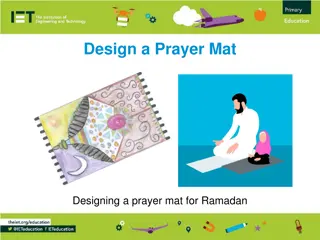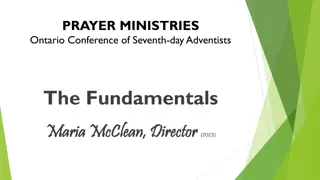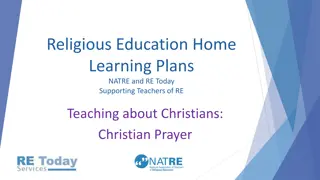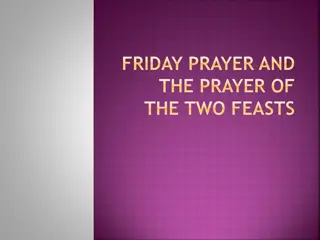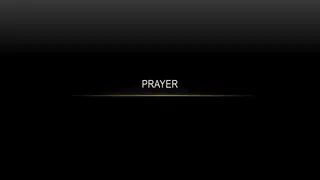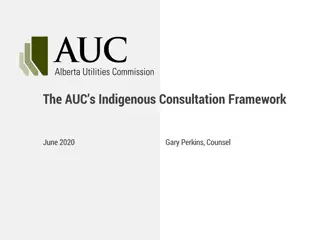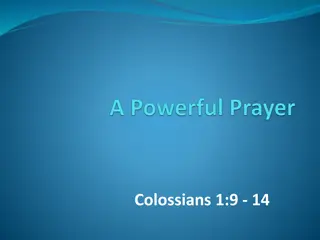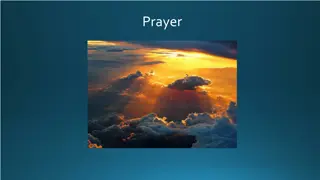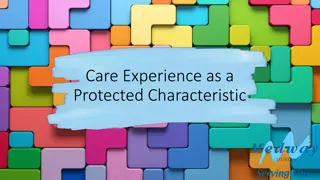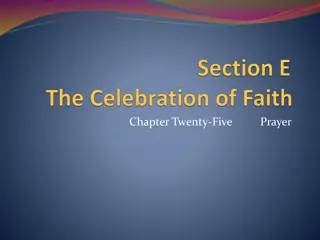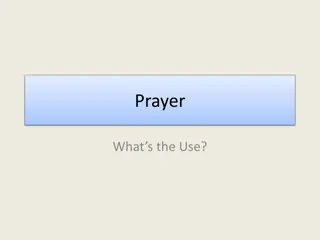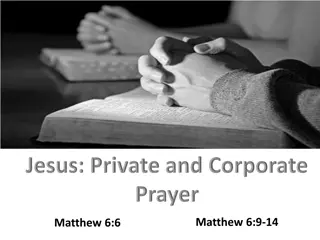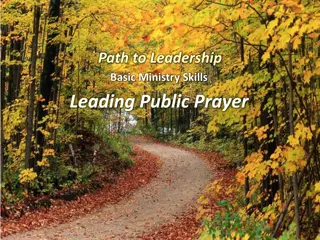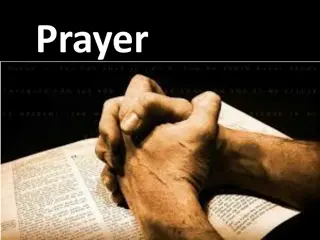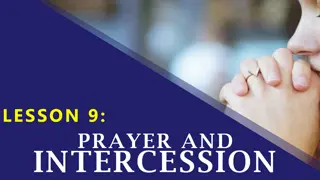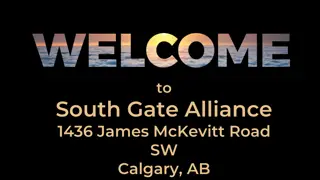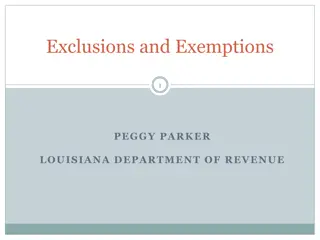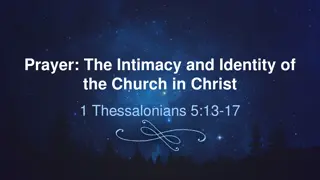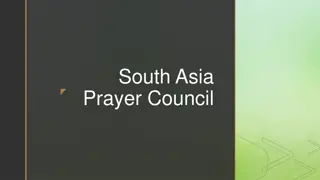
Updated Guidance on Constitutionally Protected Prayer in Public Schools
Learn about the Department of Education's updated guidance on constitutionally protected prayer and religious expression in public elementary and secondary schools. The guidance outlines the legal protections, certification process obligations for both local educational agencies (LEAs) and state educational agencies (SEAs), and requirements for compliance with the Elementary and Secondary Education Act (ESEA).
Download Presentation

Please find below an Image/Link to download the presentation.
The content on the website is provided AS IS for your information and personal use only. It may not be sold, licensed, or shared on other websites without obtaining consent from the author. If you encounter any issues during the download, it is possible that the publisher has removed the file from their server.
You are allowed to download the files provided on this website for personal or commercial use, subject to the condition that they are used lawfully. All files are the property of their respective owners.
The content on the website is provided AS IS for your information and personal use only. It may not be sold, licensed, or shared on other websites without obtaining consent from the author.
E N D
Presentation Transcript
1 Webinar: The Department of Education s Updated Guidance on Constitutionally Protected Prayer and Religious Expression in Public Elementary and Secondary Schools AUGUST 20, 2020
BACKGROUND What is the Guidance? 2 REQUIRED BY STATUTE Section 8524(a) of the Elementary and Secondary Education Act of 1965 (ESEA), as amended by the Every Student Succeeds Act and codified at 20 U.S.C. 7904(a), requires the Secretary of Education to issue guidance to State educational agencies (SEAs), local educational agencies (LEAs), and the public on constitutionally protected prayer in public elementary and secondary schools. REPRESENTS THE STATE OF THE LAW REGARDING PRAYER IN PUBLIC SCHOOLS MUST BE UPDATED EVERY TWO YEARS, PER THE ESEA
BACKGROUND Structure Part I: INTRODUCTION 3 Part II: LEGAL PROTECTIONS - PRAYER IN PUBLIC SCHOOLS LEAs must certify that no policy of the LEA prevents, or otherwise denies participation in, constitutionally protected prayer in public elementary and secondary schools, as detailed in the guidance 20 U.S.C. 7904(b). Part III: LEGAL PROTECTIONS - RELIGIOUS EXPRESSION No certification required Part IV: EQUAL ACCESS ACT No certification required
4 CERTIFICATION PROCESS OBLIGATIONS FOR LEAs As a condition of receiving funds under the ESEA, an LEA must certify in writing to its SEA by October 1 of each year that it has no policy that prevents, or otherwise denies participation in, constitutionally protected prayer in public schools as detailed in the guidance. 20 U.S.C. 7904(b). No changes from previous Guidance. Process by which LEA makes this certification is established by the SEA. If a LEA fails to file a certification OR makes such a certification in bad faith, the Secretary is legally authorized to take measures to effectuate compliance under 8524(c) of ESEA. 20 U.S.C. 7904(c).
5 CERTIFICATION PROCESS OBLIGATIONS FOR SEAs The SEA must report to the Secretary by November 1 of each year a list of LEAs that (1) have not filed the requisite certification or (2) against which complaints have been made to the SEA that the LEA has prevented, or otherwise denied participation in, constitutionally protected prayer in public schools. 20 U.S.C. 7904(b).
CERTIFICATION PROCESS OBLIGATIONS FOR SEAs Part 1 6 First requirement: The SEA must report to the Secretary a list of LEAs that have not filed the requisite certification No changes from previous Guidance SEAs must establish a process by which LEAs can provide the necessary certification. If LEA fails to file certification, SEA should ensure compliance in accordance with regular enforcement procedures. SEA should maintain LEA certifications records in accordance with usual records retention policy.
7 CERTIFICATION PROCESS OBLIGATIONS FOR SEAs Part 2 Second Requirement: The SEA must report to the Secretary a list of LEAs against which complaints have been made to the SEA that the LEA has prevented, or otherwise denied participation in, constitutionally protected prayer in public schools. Two changes from the 2003 guidance
8 CERTIFICATION PROCESS OBLIGATIONS FOR SEAs Part 2 *TWO CHANGES THAT WERE NOT SPELLED OUT IN 2003 GUIDANCE* SEAs must provide a process by which a person can file a complaint with the SEA against an LEA Protections extend to students and employees SEA must report all complaints, even those it deems meritless SEA should describe investigation and/or enforcement action that the SEA has initiated and the status of the investigation or action
9 CERTIFICATION PROCESS OBLIGATIONS FOR SEAs Part 2 *TWO CHANGES THAT WERE NOT SPELLED OUT IN 2003 GUIDANCE* If the SEA has notice of a public legal charge or complaint (such as a lawsuit) filed against a LEA which alleges that the LEA denied a person the right to participate in constitutionally protected prayer, the SEA must report that complaint to the Secretary. An SEA has this obligation whether or not someone filed a complaint with the SEA.
CERTIFICATION PROCESS SEA Certification Example 1 10 If all LEAs have submitted certifications, and the SEA has not received any complaints: [SEA] certifies that all local educational agencies (LEAs) in the State that receive funds under the Elementary and Secondary Education Act of 1965, as amended (ESEA), are in compliance with section 8524(b) of the ESEA for School Year 2020-2021. Each LEA has submitted written certification that there are no local policies preventing or denying participation in constitutionally protected prayer. Further, the [SEA] has not received any complaints alleging non-compliance with the prayer guidance.
CERTIFICATION PROCESS SEA Certification Example 2 11 If all LEAs have submitted certifications, and the SEA has received complaints: [SEA] certifies that all local educational agencies (LEAs) in the State that receive funds under the Elementary and Secondary Education Act of 1965, as amended (ESEA), are in compliance with section 8524(b) of the ESEA for School Year 2020-2021. Each LEA has submitted written certification that there are no local policies preventing or denying participation in constitutionally protected prayer. The [SEA] received [number] complaint[s] regarding the protection of constitutionally protected prayer in [name school districts]. [Provide brief description of the complaint and describe what investigation or enforcement action the SEA has initiated with respect to each listed LEA and the status of the investigation or action.]
CERTIFICATION PROCESS SEA Certification Example 3 12 If all LEAs have not submitted certifications, and the SEA has not received complaints: [SEA] received certifications that there are no local policies preventing or denying participation in constitutionally protected prayer, as required under section 8524(b) of the Elementary and Secondary Education Act of 1965, as amended (ESEA), from all but [number] local educational agencies (LEAs) that receive funds under the ESEA. The LEAs that did not submit the required certification for School Year 2020-2021 are: [list LEAs]. The [SEA] has not received any complaints alleging non-compliance with the prayer guidance.
CERTIFICATION PROCESS SEA Certification Example 4 13 If all LEAs have not submitted certifications, and the SEA has received complaints: [SEA] received certifications that there are no local policies preventing or denying participation in constitutionally protected prayer, as required under section 8524 of the Elementary and Secondary Education Act of 1965, as amended (ESEA), from all but [number] local educational agencies (LEAs) that receive funds under the ESEA. The LEAs that did not submit the required certification for School Year 2020-2021 are: [list LEAs]. The [SEA] received [number] complaint[s] regarding the protection of constitutionally protected prayer in [name school districts]. [Provide brief description of the complaint and describe what investigation or enforcement action the SEA has initiated with respect to each listed LEA and the status of the investigation or action.]
CERTIFICATION PROCESS 14 SEAs SHOULD EMAIL THEIR CERTIFICATIONS TO THE FOLLOWING ADDRESSES: TO: OESE@ed.gov CC: Sam.Ryan@ed.gov; Angel.Rush@ed.gov Note: If you are providing Personally Identifiable Information (PII) in relation to a complaint, the email must be encrypted. If you are unable to electronically send the certifications, please email OESE@ed.gov and we will identify an alternative solution.
Guidance Part I 15 CONSTITUTIONAL PRINCIPLES The Supreme Court has repeatedly held that the First Amendment requires public school officials to show neither favoritism toward nor hostility against religious expression such as prayer. See, e.g., Good News Club v. Milford Cent. Sch., 533 U.S. 98 (2001). [T]here is a crucial difference between government speech endorsing religion, which the Establishment Clause forbids, and private speech endorsing religion, which the Free Speech and Free Exercise Clauses protect. Santa Fe Indep. Sch. Dist. v. Doe, 530 U.S. 290, 302 (2000) (quoting Bd. Of Educ. V. Mergens, 496 U.S. 226, 250 (1990) (plurality opinion)). [P]rivate religious speech, far from being a First Amendment orphan, is as fully protected under the Free Speech Clause as secular private expression. Capitol Square Review & Advisory Bd. v. Pinette, 515 U.S. 753, 760 (1995). Students and teachers do not shed their constitutional rights to freedom of speech or expression at the schoolhouse gate. Tinker v. Des Moines Indep. Cmty. Sch. Dist., 393 U.S. 503, 506 (1969).
Guidance Part II Certification Required 16 PRAYER DURING NON-INSTRUCTIONAL TIME Schools May: Students May: Pray before, during, and after school when not engaged in school activities or instruction Say grace before meals Bring their Bibles, Torahs, Korans, or other religious texts to school Bring their rosaries, prayer beads, or other prayer aids to school Pray or study religious texts with other students during recess, lunch, or non-instructional time to the same extent as they can engage in nonreligious activities Impose rules of order and pedagogical restrictions Review student speeches for vulgarity, lewdness, and sexually explicit language. Bethel Sch. Dist. v. Fraser, 478 U.S. 675, 683- 86 (1986). May not disallow prayer activities or speeches just because they express an unpopular viewpoint Tinker v. Des Moines Indep. Cmty. Sch. Dist., 393 U.S. 503, 509(1969)
Guidance Part II Certification Required ORGANIZED PRAYER GROUPS AND ACTIVITIES 17 Schools May: Students May: Organize prayer groups, religious clubs, and See you at the pole gatherings before and after school to same extent they are permitted to organize other noncurricular student activities Use school facilities for assembling on the same basis as noncurricular groups Use school media to advertise or announce prayer activities to the same extent that groups meeting for nonreligious activities are permitted to use school media Disclaim sponsorship of noncurricular groups and events, provided they administer the disclaimer in a manner that neither favors nor disfavors religious groups Exercise discretion concerning whether to permit student groups to use school media for student advertising or announcements regarding noncurricular activities, but must apply any media policy equally to all groups.
Guidance Part II Certification Required 18 EXAMPLES FROM SUPREME COURT CASE LAW A school that opens up its facilities for social and civic purposes may not prohibit the use of its facilities for a lecture or film series about child rearing and family values from a religious perspective. Lamb s Chapel v. Ctr. Moriches Union Free School Dist., 508 U.S. 384, 398 (1993) A school that opens up its facilities to groups that teach moral and character development (i.e., the Boy Scouts) cannot deny its facilities to groups teaching moral and character development from a religious perspective. Good News Club v. Milford Central Sch., 533 U.S. 98 (2001)
Guidance Part II Certification Required 19 TEACHERS, ADMINISTRATORS, AND OTHER SCHOOL EMPLOYEES Prohibited Conduct Permissible Conduct School employees may take part in religious activities when the overall context makes clear that they are not participating in their official capacities When school employees are acting in their official capacities as representatives of the State, they cannot encourage or discourage prayer, or other religious activities, or actively participate in prayer or other religious activities For example, public school officials, acting in their official capacities, may not lead their classes in prayer, readings from the Bible, or other religious activities devotional
Guidance Part II Certification Required 20 EXAMPLES School employees may attend See you at the Pole events during non-school hours, but may only participate in prayer if they are not acting in an official or supervisory capacity and should make it clear to students that they are present in their personal capacities should confusion arise. They may not initiate or lead the prayers, and may not encourage or discourage students attendance or participation. School employees may take part in religious activities (such as prayer) during the workday at a time when it is permissible to engage in other private conduct such as making a personal call School employees may meet with other teachers for prayer or Bible study before school or during lunch to the same extent that they engage in other nonreligious activities or conversation School employees may participate in their personal capacities in privately sponsored baccalaureate ceremonies or similar events
Guidance Part II Certification Required 21 MOMENTS OF SILENCE Students are free to pray silently or to refrain from prayer during moments of silence. Teachers and other employees may not require, encourage, or discourage students from praying during these times.
Guidance Part II Certification Required 22 Accommodation of Prayer During Instructional Time Examples A school may excuse Muslim students from class to enable them to fulfill their religious obligations to pray during Ramadan. Students excused to pray may do so on school property A teacher may not hold up class and/or make the other students wait for a substantial period of time in order to accommodate a student excused for prayer. Schools have the discretion to dismiss students to off premises religious instruction, but may not encourage or discourage participation in such instruction or penalize students for attending or not attending. Schools may excuse students from class to remove a significant burden on their religious exercise, including prayer, where doing so would not impose material burdens on other students.
Guidance Part II Certification Required 23 Examples Prayer in Class Assignments If the assignment is to write a poem and the student submits a poem in the form of a prayer (for example, a psalm), the student should be judged on the basis of academic standards such as literary quality. The student should neither be penalized nor rewarded on account of the religious perspective. A student could pick a religious character in a class assignment that requires students to give an oral presentation about their "hero." Students may express beliefs about religion in homework, artwork, and other written and oral assignments free from discrimination based on religious perspective of the submission. Instructors should evaluate such home and classroom work by ordinary academic standards of substance and relevance and against other legitimate pedagogical concerns identified by the school.
Guidance Part II Certification Required (continued) 24 SCHOOLASSEMBLIES, NON-CURRICULAR EVENTS, and GRADUATIONS School officials may not mandate or organize prayer. Student speakers at graduations may not be selected on a basis that either favors or disfavors religious perspectives. When student speakers are selected on the basis of genuinely content-neutral, evenhanded criteria, and retain primary control over content, that expression is not attributable to the school, may not be restricted because of its religious or anti- religious content, and may include prayer. When school officials determine or substantially control content, such speech is attributable to school and may not include prayer, religious, or anti-religious content School officials may not restrict or censor prayers that they deem too religious or favor certain prayers because they are nonsectarian Schools may make neutral disclaimers
Guidance Part II Certification Required (continued) 25 EXAMPLES FROM SUPREME COURT CASE LAW School officials cannot invite a rabbi to give a prayer at graduation. Lee v. Weisman, 505 U.S. 577, 599 (1992). School cannot enact a policy authorizing a student chaplain to give an invocation before every football game. Santa Fe Indep. School Dist. v. Doe, 530 U.S. 290, 317 (2000).
Guidance Part II Certification Required (continued) 26 BACCALAUREATE CEREMONIES School officials may not mandate or organize these ceremonies. If a school chooses to make its facilities available to private groups, it must make its facilities available on the same terms to organizers of private baccalaureate ceremonies. Schools may disclaim endorsement, as long as it does so in a manner that neither favors nor disfavors religious groups.
Guidance Part III Religious Expression 27 Part III addresses the legal rules that govern religious expression in schools, which are similar to those which govern the issue of constitutionally protected prayer in public schools. Part III was not in the 2003 Guidance, but is based on guidance first published alongside prayer guidance in 1995.
Guidance Part III Religious Expression (continued) 28 RELIGIOUS LITERATURE Students Schools May impose reasonable time, place, and manner restrictions on the distribution of religious literature, as long as the restrictions are imposed to the same extent on other non-school literature May not single out religious literature for special regulation May not disallow distribution just to avoid the discomfort or unpleasantness that comes from an unpopular viewpoint Students religious literature on the same terms as they can distribute other literature unrelated curriculum or activities EXAMPLES Students can Christmas cards or religious tracts during non-instructional time Students may wish classmates and teachers a Merry Christmas, Happy Hanukkah, or give other religious holiday greetings can distribute to school pass out Tinker v. Des Moines Indep. Cmty. Sch. Dist., 393 U.S. 503, 509(1969)
Guidance Part III Religious Expression (continued) 29 TEACHING ABOUT RELIGION Prohibited Conduct Permissible Conduct Public schools may teach about religion Examples: Philosophical questions History of religion Comparative religion Religious texts as literature Role of religion in history Religious influences on philosophy, art, music, literature, and social studies May teach about religious holidays and celebrate the secular aspects of holidays Religious Instruction Public schools may not observe holidays as religious events or promote such observance by students
Guidance Part III Religious Expression (continued) 30 Student Dress Codes and Policies Examples Students may display religious messages on items of clothing to the same extent that they are permitted to display other comparable messages. A school may not use a no hats policy to prevent a Muslim student from wearing her hijab or a Jewish student from wearing his yarmulke. Students may keep ashes on their foreheads on Ash Wednesday. Schools have substantial discretion in adopting policies relating to student dress and uniforms. However, schools may not single out religious attire in general or attire related to a particular religion for prohibition or regulation. If a school makes exceptions to the dress code for nonreligious reasons, it must make exceptions for religious reasons, absent a compelling justification. May not disallow certain messages just to avoid the discomfort or unpleasantness that comes from an unpopular viewpoint. Tinker v. Des Moines Indep. Cmty. Sch. Dist., 393 U.S. 503, 509(1969)
Guidance Part III Religious Expression (continued) 31 RELIGIOUS EXCUSALS Where school officials have a practice of excusing students from class on the basis of parents requests for accommodation of nonreligious needs, religiously motivated requests for excusal may not be accorded less favorable treatment. Students excused to pray may do so on school property In some circumstances, schools may be required to make accommodations that relieve substantial burdens on students religious exercise. School officials are encouraged to consult with their attorneys regarding such obligations.
Guidance Part IV Equal Access Act, 20 U.S.C. 4071 32 The Act was designed to ensure that federally funded public secondary schools that open up their facilities for student groups grant equal access to both religious and secular groups. The Act only applies to public secondary schools.
Guidance Part IV Equal Access Act (continued) 33 Under the Equal Access Act, a public secondary school receiving Federal funds that creates a limited open forum may not refuse student religious groups access to that forum. A limited open forum exists whenever such school grants an offering to or opportunity for one or more noncurriculum-related student groups to meet on school premises during noninstructional time. 20 USC 4071(b). This covers all times when the school allows student groups to meet, including before or after school, the lunch period, or other non-instructional time.
Guidance Part IV Equal Access Act (continued) 34 Prayer and Worship Media Religious student groups that meet may engage in prayer, the reading of religious texts, or worship. Public secondary schools must allow religious secular student groups to have equal access to school media to publicize meetings. Any restrictions must be applied to all groups equally. The school disclaimers. and may make
Guidance Part IV Equal Access Act (continued) 35 Leadership of Religious Student Groups Religious student groups may restrict leadership positions to individuals who are members of their religion, if these positions affect the religious content of the speech at the group s meetings. For example, a religious student group may require their president, vice president, or music coordinator to be dedicated members of a particular religion if their duties consist of leading prayers, devotions, or safeguarding the spiritual content of their meetings.
Guidance Part IV Equal Access Act (continued) 36 EXAMPLES FROM SUPREME COURT CASE LAW A school that allows a Christian club to meet informally after school but does not allow it to be part of its student activities program and prohibits it access to school newspaper, bulletin boards, public address system, and annual club fair is in violation of the Equal Access Act. Bd. of Educ. of Westside Cmty. Sch. v. Mergens By & Through Mergens, 496 U.S. 226 (1990)
37 Department of Justice, Civil Rights Division website: www.justice.gov/crt Civil Rights Division complaint portal: https://civilrights.justice.gov/ Eric Treene, Special Counsel on Religious Discrimination and Religious Liberty: Eric.Treene@USDOJ.gov
38 For more information, contact the Office of Elementary and Secondary Education at the Department of Education: OESE@ed.gov

